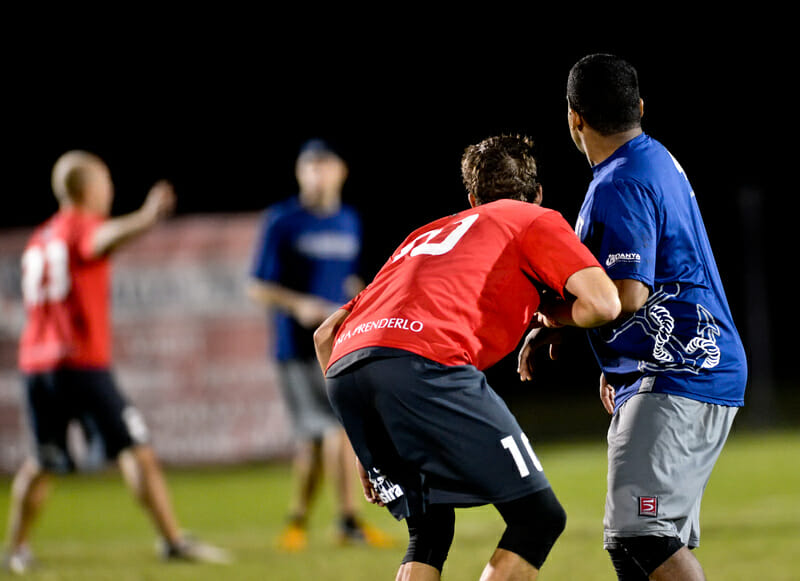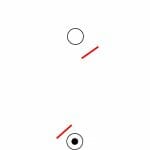It's time to move beyond the simplistic mantra "Never get burned deep."
March 8, 2016 by Sean Myers in Opinion with 2 comments

As a defender, one of the biggest decisions that you’ll have to make in guarding a cutter is whether to prioritize taking away the under cuts or the deep cuts. Your decision determines whether you should shade your mark deep (or “high“), focusing on taking away the huck, or shading your mark underneath (or “low”), preventing cuts toward the disc.
|
|
|
Making this decision is not always an easy one, especially for newer players. They perhaps were taught early on that the cardinal rule defensively is, “Never get burned deep,” and have come to believe that it means defenders should always shade deep in their coverage. But often that rule is just an oversimplification of a more sensible approach to defense: “Take away the most dangerous threat.”
In many cases, shading deep may be an appropriate default position, all other things being substantially equal. But as players learn over time, a far more nuanced understanding of defensive positioning will shed light on when to take this approach and when there is a more effective option. Giving up under cut after under cut only makes it take longer for the offense to score, and baiting the offense into an ill-advised deep shot can create a turnover and an opportunity for a break point.
There are several determinants that, once understood and recognized, should strongly influence your decision of whether to focus on taking away the deep look or the short throw. So, when making a choice about where to position yourself on downfield defense, consider the following factors:
1.Vertical field position
How many yards does the offense need to go to score? If they’re ten yards out from your endzone, there’s no reason to take away the deep shot — there is no deep shot, only out the back of the endzone. As the offense penetrates further into your side of the field, both the angle and cushion you give your mark should shrink, accordingly.
2. Height
On deep throws, height is basically a tiebreaker. If a huck floats, height often becomes the deciding factor, with the taller player far more likely to make the catch. However, height is significantly less meaningful on an under cut. If your mark is more than a couple inches taller than you are, you should lean towards shading deep, forcing your mark to take the under. If you have the height advantage, consider pushing your mark into a deep cut that forces the thrower into a demanding toss.
3. Speed
It often only takes a couple of cuts to determine whether the player you’re guarding is faster than you. A speed advantage for the offense, like a height advantage, makes a deep look considerably more dangerous – all that the thrower has to do is put a deep throw into space within catching height, and let the faster cutter win the race to the disc. If your mark is definitively faster than you are, that should push you into shading deep. However, if you have the speed advantage, you should consider focusing more on taking away the under cut by shading under, or at least decreasing the cushion you’re giving them. Having a speed advantage lets you reel in your mark in a race to a spot, but this is much easier to do when the race is a 30-yard dash after a huck than when it’s a 7-yard cut underneath.
4. Weather
Adverse weather conditions, particularly the wind, impact the deep game much more than they impact the short game. Considerable amounts of wind, rain, or snow should make you lean towards pushing your mark deep, knowing throwers will not have the same confidence or consistency in hitting long passes. Focus on taking away the under cuts that are the much higher percentage throw in less-than-deal conditions.
5. Jumping ability
Less immediately apparent than height or even speed, you typically won’t know the jumping ability of your mark until after you’ve been challenged. But once you’re aware of how you match up, it should become a factor in how your decide to position yourself to dictate their cuts. Jumping ability will primarily influence deep shots — as they are more likely to hang — so if you have the advantage, consider pushing your mark deep. This is especially effective if you’ve just ruined your mark in the air – if you focus on taking away the under cut and your cutter busts deep, but the thrower sees that it’s the same matchup that resulted in a turnover last time, they’ll probably holster the throw. Mission accomplished.
6. Horizontal field location
As a cutter, viable routes change dramatically if you’re in the middle of the field or positioned well into either the force or the break side. A cutter already on the break side can do little with an under cut because of the mark on the thrower, but is a significant threat to attack deep because of how much space there is to float a throw deep in open space. Cutting into that same space from the force side of the field, however, would force the thrower to attempt a much more difficult throw into a tighter window. Your positioning as a downfield defender, therefore, should account for where your mark is on the field, horizontally speaking. Lean towards pushing them deep if they’re closer to the force side; lean towards pushing them under if they’re on the break side.
7. Team or game tendencies
Some teams huck a lot. This is a reason to shade their cutters deep. Other teams get huck happy every once in awhile. If you’ve noticed that they’ve started bombing it a lot, start shading your mark deep to try to take away that look. If they miss several hucks and call a timeout or there’s an extended play stoppage that lets them regroup and adjust their playing style, know that they’re probably going to focus on unders more often. Shift your shading appropriately.
8. The handler’s throwing ability
If you know that the person with the disc only throws to under cuts, why would you focus on preventing a deep cut? Your shading decision should pressure your mark into a cut that they don’t want to take, but the cut they want is often dictated by who has the disc. Just make sure that you aren’t caught out of position if the disc changes hands to someone who can huck.
9. Your mark’s throwing ability
Your mark’s throwing ability might seem like a strange factor to consider when deciding how to position yourself defensively against them as they are cutting. However, pushing a weak thrower to the disc can at times present a good opportunity for a turnover — especially as they are further from the scoring endzone. If you’ve noticed that the player you’re guarding has little confidence with their throws, or only looks to dump once they have the disc, focus on taking away their deep cut. Push them under, and if they get the disc, play an aggressive mark on them to pressure them into a throwing mistake.
Conclusion
While not meant to be an exhaustive list of factors to consider, each of these plays a role in deciding where to position yourself on defense. But none exists in isolation; like any list of pros and cons, these elements will often be in conflict with each other. There is no consistent rule on how exactly to balance all of these — and other — factors.
Additionally, the decision to focus on preventing deep cuts or unders is not an absolute one. There’s a huge middle ground between giving your mark a huge, 8-yard cushion downfield to try to prevent deep throws, and face-guarding your mark, three yards upfield to harass the undercut.
In time, with intentional and reflective practice, you will learn how these different factors play off each other so you can start to recognize where the most dangerous threats are for your mark. This will help you move beyond the “Never get burned deep” mantra and become a more proactive defensive thinker.

